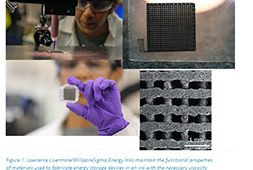New technique published in Advanced Materials shows the process of 3-D printing silicone rubber.
Using the principles behind the formation of sandcastles from wet sand, North Carolina State University researchers have achieved 3-D printing of flexible and porous silicone rubber structures through a new technique that combines water with solid and liquid forms of silicone into a pasty ink that can be fed through a 3-D printer. The finding could have biomedical applications and uses in soft robotics.
In a paper published in Advanced Materials, corresponding author Orlin Velev and colleagues show that, in a water medium, liquid silicone rubber can be used to form bridges between tiny silicone rubber beads to link them together – much as a small amount of water can shape sand particles into sandcastles.
Interestingly, the technique can be used in a dry or a wet environment, suggesting that it has the potential to be used in live tissue – think of an ultraflexible mesh encapsulating a healing droplet, or a soft bandage that can be applied or even directly printed on some portion of the human body, for example.
“There is great interest in 3-D printing of silicone rubber, or PDMS, which has a number of useful properties,” said Velev, INVISTA Professor of Chemical and Biomolecular Engineering at NC State. “The challenge is that you generally need to rapidly heat the material or use special chemistry to cure it, which can be technically complex.
“Our method uses an extremely simple extrudable material that can be placed in a 3-D printer to directly prototype porous, flexible structures – even under water,” Velev added. “And it is all accomplished with a multiphasic system of just two materials – no special chemistry or expensive machinery is necessary. The ‘trick’ is that both the beads and the liquid that binds them are silicone, and thus make a very cohesive, stretchable and bendable material after shaping and curing.”
The research is funded by the National Science Foundation and by the Research Triangle Materials Research Science and Engineering Center on Programmable Soft Matter. NC State has filed a provisional patent on the new technique.




